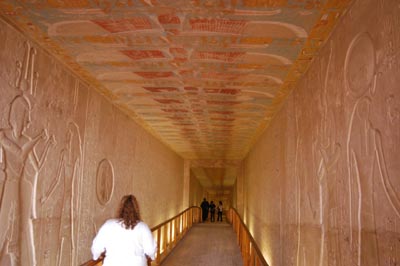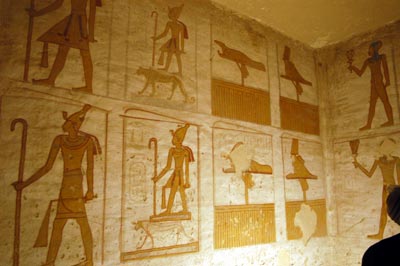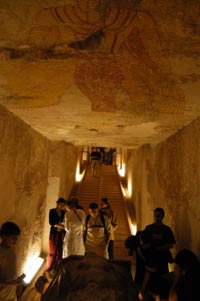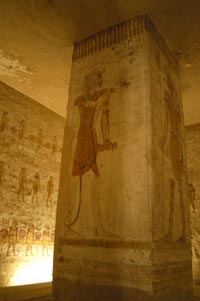










more photos
[ 1 ] [ 2 ]
site details
0700-1800 daily summer
0700-1500 daily winter
E£20 for 3 tombs
E£40 tutankhamun
E£10 camera per tomb
no flash
no video cameras
relevant links
traveloque 2/14
theban mapping project
history
New Kingdom
18th Dynasty
19th Dynasty
20th Dynasty
Thutmose III
Tutankhamun
Ramesses II
Merenptah
Seti II
Tausert
Ramesses III
Ramesses IX\
Tomb of Seti II

The tomb of Seti II is rarely visited -- it lies at the end of the wadi and is often overlooked by hordes of tourists flocking to see Tut's tomb. It was used for storage and as a restoration area during the excavation of Tutankhamun's tomb. Howard Carter (who discovered Tut) performed the excavation on the tomb in 1903-4, but he did not completely clear the tomb..
The tomb has been open since antiquity and was considered "uninteresting" and so was used as storage. Like Ramesses III's tomb, it contains almost 60 instances of greek and Latin graffiti on the walls.

It is a straight tomb, consistent with the 19th Dynasty style. It is decorated with colorful scenes, but only those near the entrance were carved (and these appear to never have been painted). The rest are painted or even unfinished drawings. Beyond the first corridor, the walls are unplastered, althougn they are painted with rough scenes. It is assumed that this tomb was finished hastily by Sekhnakht when Seti II died. . Deep inside the tomb, reliefs are again found. It is very obvious that this tomb was finished by several different groups of people.


The tomb does have some unique characteristics that later become standard -- it includes wall niches in the pillareed halls, the entrance is cut directly into the rock face without a staircase or courtyard.